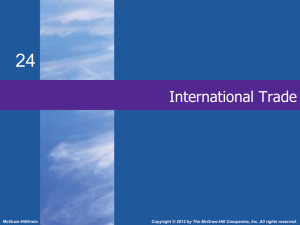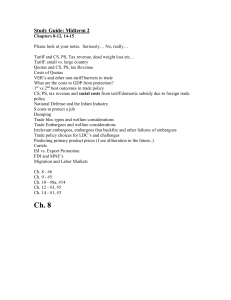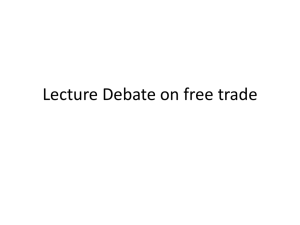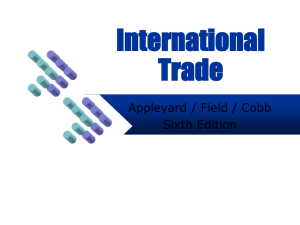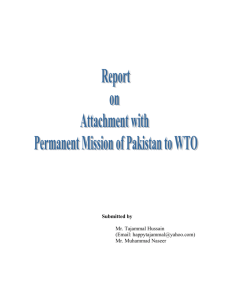Hypothesis
advertisement
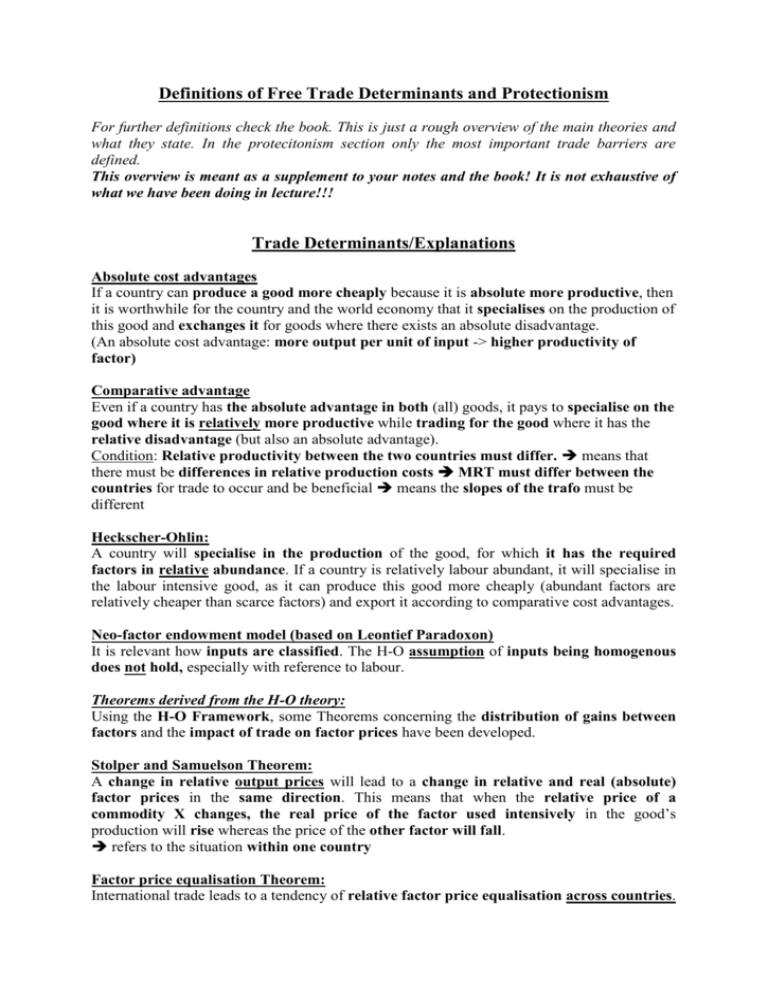
Definitions of Free Trade Determinants and Protectionism For further definitions check the book. This is just a rough overview of the main theories and what they state. In the protecitonism section only the most important trade barriers are defined. This overview is meant as a supplement to your notes and the book! It is not exhaustive of what we have been doing in lecture!!! Trade Determinants/Explanations Absolute cost advantages If a country can produce a good more cheaply because it is absolute more productive, then it is worthwhile for the country and the world economy that it specialises on the production of this good and exchanges it for goods where there exists an absolute disadvantage. (An absolute cost advantage: more output per unit of input -> higher productivity of factor) Comparative advantage Even if a country has the absolute advantage in both (all) goods, it pays to specialise on the good where it is relatively more productive while trading for the good where it has the relative disadvantage (but also an absolute advantage). Condition: Relative productivity between the two countries must differ. means that there must be differences in relative production costs MRT must differ between the countries for trade to occur and be beneficial means the slopes of the trafo must be different Heckscher-Ohlin: A country will specialise in the production of the good, for which it has the required factors in relative abundance. If a country is relatively labour abundant, it will specialise in the labour intensive good, as it can produce this good more cheaply (abundant factors are relatively cheaper than scarce factors) and export it according to comparative cost advantages. Neo-factor endowment model (based on Leontief Paradoxon) It is relevant how inputs are classified. The H-O assumption of inputs being homogenous does not hold, especially with reference to labour. Theorems derived from the H-O theory: Using the H-O Framework, some Theorems concerning the distribution of gains between factors and the impact of trade on factor prices have been developed. Stolper and Samuelson Theorem: A change in relative output prices will lead to a change in relative and real (absolute) factor prices in the same direction. This means that when the relative price of a commodity X changes, the real price of the factor used intensively in the good’s production will rise whereas the price of the other factor will fall. refers to the situation within one country Factor price equalisation Theorem: International trade leads to a tendency of relative factor price equalisation across countries. Rybczynski-Theorem If the quantity of the factor rises that is mainly used in the production of a good X, then the quantity produced of this good will increase and the output of good Y, for which the input is not used intensively, will fall. Further Trade Flow Explanations Economies of scale: Trade leads to an enlargement of narrow markets and allows for existing and potential EOS to be used and therewith per unit costs reduced. The reduction of unit costs can give the producers a competitive edge in international markets. Gains are derived form specialisation, regardless of which country specialises in which good. EOS with comparative cost advantages: With comparative cost advantage the national price lines would vary between the two countries => different points on the trafo curve => does matter which good the countries specialise Availability (Kravis) A country will import goods if it does not have the required inputs for their production. This can be due to climatic, geographical or other natural reasons. Same argument applies for prohibitive high costs of production! Vent for Surplus theory Vent for Surplus explains trade through over-capacities of production: The economy produces more than it consumes. Trade can be an outlet of the excess capacities! Transport costs can influence the a) creation of trade b) intensity of trade Differences in Technology: Product Cycle As a good passes through its different phases in its life cycle the production technology needed changes from high tech to increasingly relatively labour intensive. This means that comparative advantages change continuously and hence trade flows too. Intra-Industry Trade Trade occurs because people perceive very similar goods to be different. Intra-industry trade means that goods from the same industry are traded between countries. This explanation tells us why Fords are sold in Germany and Mercedez in the USA although they are both cars. looks horizontal, along one industry line Similar/Overlapping demand Linder stated: Trade is determined by similar demand structures across countries. Goods are produced for the domestic market and if consumers in two countries share a fancy, that means have the same preference for the good, only then will it be exported Differences in demand and preference structures Demand is important to determine the national production point (on the transformation schedule) as only those things that are demanded will be produced. What is important to note is that in the case of differing demand structures there is no specialisation of production but a convergence of production structures of the two countries. PROTECCTIONISM Tariffs Def.: A tariff is a tax that is imposed on a good as it crosses the border into another country The general effect of a tariff is to raise the Import P => this reduces the import volume Quotas Def.: Quotas are quantative restrictions on the import volume of a country for a specific time period. It is based on a decision of the policy makers. Whereas tariffs artificially raise the price of the imports, quotas restrict the volume of imports and therewith only indirectly the prices. Voluntary Export Restraint Def.: Through negotiations the exporter “voluntarily” agrees to limit the volume of its exports to the negotiation partner’s country. It is like a self imposed quota. Antidumping duties Antidumping tariffs are tariffs that are implemented to counteract the, what is considered unfair, trade behaviour of dumping. The duty works the same way as a regular tariff. Dumping Dumping is a type of international price discrimination which means that prices in export markets for the same good are lower than they are sold domestically. There is a divergence between domestic price and export price. Subsidies and export subsidies Def.: Subsidies: are payments from the government to help an industry cover its costs Domestic content requirements: Means that only a good that has been produced to a certain percentage in the importing country will be accepted tariff free into the country. Goods that do not have the sufficient share in domestic content will be subject to a tariff. Rules of origin: Are domestic content requirements that are used in connection with economic integration. Especially in free trade areas, where there is no common external tariff, it is perceivable that a foreign good is imported into the integration country with the lowest external tariff and then exported tariff free to the final destination country, avoiding their higher tariff.






